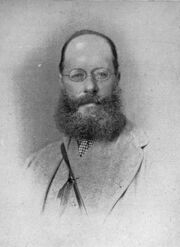
Portrait of Edward Lear (1867)
Edward Lear (May 12, 1812 - January 29, 1888) was a popular Victorian English artist and writer. He was a landscape painter and a respected illustrator of birds and animals in his day. He also published illustrated travel journals. Today he is best remembered for his humorous nonsense poems and the whimsical pen-and-ink drawings that accompany them.
Lear's first volume of nonsense work, A Book of Nonsense, was a collection of limericks he wrote for the grandchildren of his patron Lord Stanley, Earl of Derby. First published in 1846 and later expanded, it helped popularize the limerick form. Lear went on to write many more limericks and other forms of nonsense verse as well as short stories. His most famous poems include "The Owl and the Pussycat", "The Jumblies", "The Dong with a Luminous Nose", and "The Pobble Who Has No Toes".
Edward Lear is one of the best known authors of literary nonsense along with Lewis Carroll.
Biography[]
Edward Lear was born on May 12, 1812, to Jeremiah Lear and his wife Ann Clark Skerrett in Holloway, North London. He was the twentieth of 21 children. Jeremiah, a stockbroker, was bankrupted when Edward was only four years old. The family was broken up and Edward was brought up by his eldest sister Ann who was twenty-one years his senior. He was educated at home by Ann and another sister named Sarah. The sisters also taught him to draw, and Edward began drawing for money at age 15.

Macrocercus ararauna (blue and yellow macaw) by Edward Lear from Illustrations of the family of Psittacidœ, or Parrots (1832)
Lear's talents were quickly recognized, and he became an ornithological illustrator for the London Zoological Society in 1830. The following year, he began working with ornithologist John Gould and traveled with him to Europe. In 1832, Lear was invited by Lord Stanley, Earl of Derby, to stay at his estate and make illustrations of his private menagerie. Lear worked at the estate off and on till 1836.
While traveling in Ireland with Lord Stanley in 1836, Lear developed an interest in landscape painting. He enrolled at Sass's School of Art and went on a sketching tour of the Lake District. Around the same time, Lear's health deteriorated. He had suffered from asthma in addition to epilepsy and depression from an early age, and he found it more and more difficult to deal with the English climate. In 1837, with help from Lord Stanley, Lear left for Rome.

Rome, a View of the Forum from a Terrace by Edward Lear (1841)
After traveling around sketching and painting, Lear returned to England in 1845 and published a set of travel journals Illustrated Excursions in Italy (1846) in two volumes. He was invited by Queen Victoria, who admired his work, to give her a series of 12 drawing lessons. Lear also published a collection of limericks in 1846 entitled Book of Nonsense. Most of the limericks had originally been written for the enjoyment of Lord Stanley's grandchildren.
Lear returned to Rome at the end of 1846. He traveled and sketched in Southern Italy, Greece, and surrounding areas including Egypt before returning to England in 1849. He was accepted as a student at the Royal Academy in 1850, but he never completed his formal studies. Instead, he studied on his own and published more travel journals in the next few years. In 1852, Lear met and studied privately with the Pre-Raphaelite painter William Holman Hunt. He also met the poet Alfred, Lord Tennyson and his wife Emily, and they became good friends. Lear, who was an amateur musician, soon began to compose and publish musical settings to Tennyson's poems. He would also later illustrate some of the poems.

Edward Lear Aged 73 and a Half and His Cat Foss, Aged 16, a lithograph by Edward Lear (1885)
Beginning in 1853, Lear traveled extensively around the Mediterranean and the Near East, spending only occasional summers in England. In 1870, he finally decided to settle down in Italy. He built a villa, named Villa Emily after Tennyson's wife, in San Remo. In the following years, Lear published three more collections of nonsense verse and stories in addition to volumes of illustrations. He also continued to travel. His last major trip was a year-long one in India and Ceylon from 1873 to 1874.
Lear's later years were mostly spent in San Remo. After a new hotel blocked the view from Villa Emily, Lear moved into a new villa. It is said that the second villa, named Villa Tennyson, was built as an exact replica of Villa Emily so as not to disorient Lear's beloved tabby cat Foss.
Lear died from heart disease in San Remo on January 29, 1888, just two months after the death of Foss.
Selected works[]

Original illustration for "There was a Young Lady of Hull" by Edward Lear, from A Book of Nonsense (1846)
- Illustrated Excursions in Italy (1846)
- A Book of Nonsense (1846)
- Journal of a Landscape Painter in Greece and Albania (1851)
- Journal of a Landscape Painter in Southern Calabria (1852)
- Journal of a Landscape Painter in Corsica (1870)
- Nonsense Songs, Stories, Botany and Alphabets (1871), including "The Owl and the Pussycat"
- More Nonsense, Pictures, Rhymes, Botany, etc. (1872)
- Laughable Lyrics (1877)
